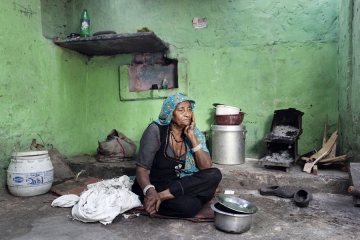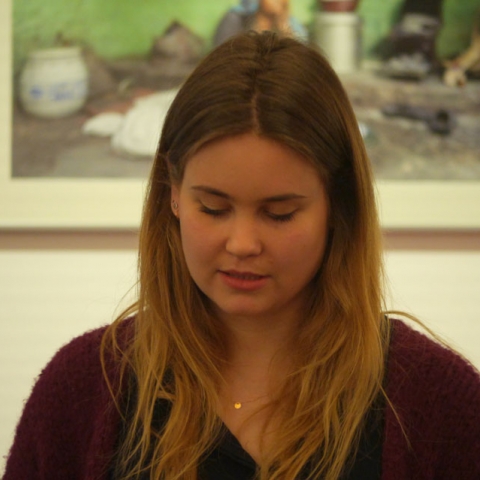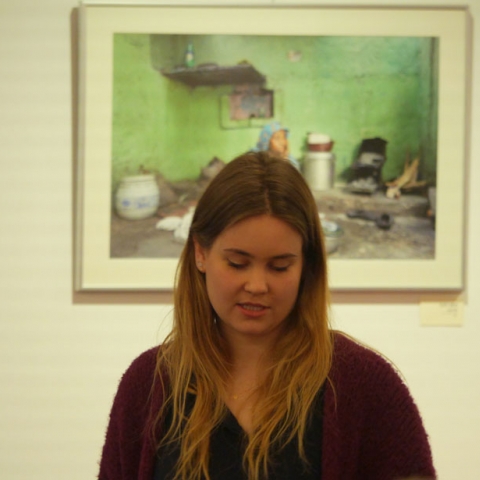Veranstaltungsinfo
Johanna Schlüter: Kathputli Colony
Die Kathputli Colony ist ein Slum im Nordwesten Delhis. Nicht irgendein Slum - sondern, mit mehr als 2800 Familien eine der größten Gemeinschaften von traditionellen Straßenkünstlern weltweit. Was vor über 60 Jahren als Ansammlung von umherziehenden Puppenspielern aus Rajasthan begann, die es auf der Suche nach Wiederanerkennung ihrer Kunst in die Hauptstadt verschlug, ist im Laufe der Jahre das Zuhause von zahlreichen Magiern, Feuerspuckern, Akrobaten, Schlangenbe- schwörern, traditionellen Tänzern, Musikern und anderen Artisten aus ganz Indien geworden. Doch seit 2009 - dem Jahr, in dem die Regierung das Land auf dem die Kathputli Colony steht, an Bauunternehmer verkauft hat - leben die Menschen dort mit der ständigen Angst, umgesiedelt zu werden. Moderne Wohnkomplexe und Einkaufszentren werden die Künstler nicht nur aus ihrer Heimat vertreiben, sondern auch Jahrhunderte alte Traditionen und damit einen wichtigen Teil der indischen Kultur zerstören. Eine fotografische Dokumentation - bevor dieser besondere Ort für immer verschwindet.
SZ-Porträt über Johanna Schlüter: "Auszeichnung - Glück und Elend"
Einführung: BARBARA BECK, Kulturreferentin Landkreis Starnberg
Dokumentarfilm: "TOMORROW WE DISSAPPEAR" von Jimmy Goldblum & Adam Weber
______________
Walking through the narrow alleys of this evil-smelling maze - you could imagine magical and illusionary happening at any moment.The Kathputli Colony is one of the largest communities of street performers in the world.
More than 2800 families call this place their home, squeezed together on limited space in this artistic slum.
Around sixty years ago, the Bhatt family, a bunch of gypsy puppeteers, found their way from Rajasthan to the suburbs of Delhi. They had chosen to move to the capital, because the Maharajas and rich merchants lost inte- rest in their arts shortly after India’s independence was declared. Arriving on no man’s land they started to set up their tents. As the years went by more and more street artists, coming from all parts of India, accompanied and settled down in Kathputli Colony - magicians, acrobats, monkey trainers and snake charmers, traditional dancers and folk musicians.
Over the time this extraordinary variety became an organized community and soon brick or wooden houses re- placed the tents. While modern world’s growth and change never stopped outside the colony, Kathputli’s artists always kept their lifestyle up and lived together in this dense closeness. All their knowledge and tradition is con- sistently being passed on from one generation to the next.Therefore many ancestral arts and thus an important part of India’s culture could be retained.
Hard to believe, all this is about to disappear.
Since 2009 the families of Kathputli Colony are under constant threat of eviction. At this time the New De- lhi government sold their land to developers, who aim to commercialize the whole area. Huge shopping malls and high-rise apartment complexes shall replace the slum. Thereby the cityscape is meant to change for the better and the living conditions are intended to be improved. But the plan’s negative effects are un- deniable. Still the builder-owners already started to put up transit camps to accommodate the residents for a certain time, while their homes are destroyed and new dwelling facilities are built. But the artists re- sist being expelled from their homes from one day to the next and try to find a way to unite. Some peo- ple ask, why they would always return to the slum, even though many of them have already traveled the world and made a name on their art.
But as I learned in my time in Kathputli the people who live here are more than satisfied with their life and don’t want to leave it behind, facing an unsecure future.
Getting to know Kathputli Colony you can see how much effort and passion the artists expend to preserve the place they call home. Is a modernized city worth the abandonment of such long grown artist’s tradition and uniqueness? A reappearing question on my mind while I got the chance to come along with the Bhatt family’s descendants and spent some time in the Kathputli Colony in March 2015.
However I tried to honor the colourful vibrancy of this place and its people‘s fading confidence in fortune by capturing some of the presumably last moments at this impressive place, halfway between horror and wonder...
SZ-Porträt über Johanna Schlüter: "Auszeichnung - Glück und Elend"
Einführung: BARBARA BECK, Kulturreferentin Landkreis Starnberg
Dokumentarfilm: "TOMORROW WE DISSAPPEAR" von Jimmy Goldblum & Adam Weber
______________
Walking through the narrow alleys of this evil-smelling maze - you could imagine magical and illusionary happening at any moment.The Kathputli Colony is one of the largest communities of street performers in the world.
More than 2800 families call this place their home, squeezed together on limited space in this artistic slum.
Around sixty years ago, the Bhatt family, a bunch of gypsy puppeteers, found their way from Rajasthan to the suburbs of Delhi. They had chosen to move to the capital, because the Maharajas and rich merchants lost inte- rest in their arts shortly after India’s independence was declared. Arriving on no man’s land they started to set up their tents. As the years went by more and more street artists, coming from all parts of India, accompanied and settled down in Kathputli Colony - magicians, acrobats, monkey trainers and snake charmers, traditional dancers and folk musicians.
Over the time this extraordinary variety became an organized community and soon brick or wooden houses re- placed the tents. While modern world’s growth and change never stopped outside the colony, Kathputli’s artists always kept their lifestyle up and lived together in this dense closeness. All their knowledge and tradition is con- sistently being passed on from one generation to the next.Therefore many ancestral arts and thus an important part of India’s culture could be retained.
Hard to believe, all this is about to disappear.
Since 2009 the families of Kathputli Colony are under constant threat of eviction. At this time the New De- lhi government sold their land to developers, who aim to commercialize the whole area. Huge shopping malls and high-rise apartment complexes shall replace the slum. Thereby the cityscape is meant to change for the better and the living conditions are intended to be improved. But the plan’s negative effects are un- deniable. Still the builder-owners already started to put up transit camps to accommodate the residents for a certain time, while their homes are destroyed and new dwelling facilities are built. But the artists re- sist being expelled from their homes from one day to the next and try to find a way to unite. Some peo- ple ask, why they would always return to the slum, even though many of them have already traveled the world and made a name on their art.
But as I learned in my time in Kathputli the people who live here are more than satisfied with their life and don’t want to leave it behind, facing an unsecure future.
Getting to know Kathputli Colony you can see how much effort and passion the artists expend to preserve the place they call home. Is a modernized city worth the abandonment of such long grown artist’s tradition and uniqueness? A reappearing question on my mind while I got the chance to come along with the Bhatt family’s descendants and spent some time in the Kathputli Colony in March 2015.
However I tried to honor the colourful vibrancy of this place and its people‘s fading confidence in fortune by capturing some of the presumably last moments at this impressive place, halfway between horror and wonder...










